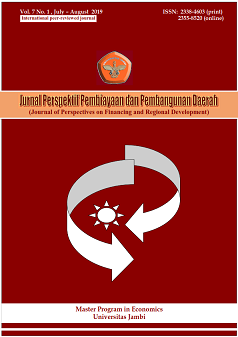Application of Altman Bankruptcy prediction model in Ghana
DOI:
https://doi.org/10.22437/ppd.v7i1.7558Keywords:
Altman Z-Score, Bankruptcy, Firms, GhanaAbstract
The study examined the applicability of the Altman Z-score model in predicting bankrupt companies or financially distressed companies on the Ghana Stock Exchange. A sample 10 listed firms were selected and one other company to be used for validation purposes. The validation process involved data for 2016 and 2017 for Aluworks which represented a distressed company and GOIL Ghana Limited which represented non-distressed company. The final analysis was based on a random sample of 10 listed firms using their 2017 financial statement. The results of the initial prediction showed 50 percent of the companies were correctly predicted whiles the others were misclassified. Additional analyses showed that the size of the company influence the probability of bankruptcy whiles the nature of the business does not. The conclusion drawn shows that the Altman Z-score cannot accurately predict financially distressed firms in Ghana but can still be useful in giving signals.
Downloads
References
Altman, E.I. (1973). Predicting railroad bankruptcies in America. Bell Journal of Economics, 4(1), 184-211.
Altman, E.I. (1984). The success of business failure prediction models: An international survey. Journal of Banking & Finance, 8(2), 171-198.
Altman, E.I., & Narayanan, P. (1997). An international survey of business failure classification models. Financial Markets, Institutions & Instruments, 6(2), 1-57.
Altman, E. I., Haldeman, R. G., & Narayanan, P. (1977). ZETATM analysis A new model to identify bankruptcy risk of corporations. Journal of banking & finance, 1(1), 29-54.
Amoa-Gyarteng, K. (2014). Analyzing a listed firm in Ghana for early warning signs of bankruptcy and financial statement fraud: An empirical investigation of AngloGold Ashanti. European Journal of Business and Management, 6(5), 10-17.
Appiah, K.O. (2011). Corporate failure prediction: some empirical evidence from listed firms in Ghana. China-USA Business Review, 10(1).
Appiah, K.O., Chizema, A., & Arthur, J. (2015). Predicting corporate failure: a systematic literature review of methodological issues. International Journal of Law and Management, 57(5), 461-485.
Argenti, J. (1984). Predicting corporate failure. Institute of Chartered Accountants in England and Wales.
Barnes, P. (1990). The prediction of takeover targets in the UK by means of multiple discriminant analysis. Journal of Business Finance & Accounting, 17(1), 73-84.
Beaver, W.H. (1966). Financial ratios as predictors of failure. Journal of accounting research, 71-111.
Beaver, W.H. (1968). Market prices, financial ratios, and the prediction of failure. Journal of accounting research, 179-192.
Daily, C.M., & Dalton, D.R. (1994). Bankruptcy and corporate governance: The impact of board composition and structure. Academy of Management journal, 37(6), 1603-1617.
Datta, S., & Iskandar-Datta, M.E. (1995). Reorganization and financial distress: An empirical investigation. Journal of Financial Research, 18(1), 15-32.
Deakin, E.B. (1972). A discriminant analysis of predictors of business failure. Journal of accounting research, 167-179.
Durand, D. (1941). Risk elements in consumer installment financing. New York: National Bureau of Economic Research.
Grice, J.S., & Dugan, M.T. (2001). The limitations of bankruptcy prediction models: Some cautions for the researcher. Review of Quantitative Finance and Accounting, 17(2), 151-166.
Jones, F.L. (1987). Current techniques in bankruptcy prediction. Journal of accounting Literature, 6(1), 131-164.
Mahama, M. (2015). Assessing the state of financial distress in listed companies in Ghana: Signs, sources, detection and elimination–A Test of Altman’s Z-Score. European Journal of Business and Management, 7(3), 1-10.
Opoku Appiah, K., & Abor, J. (2009). Predicting corporate failure: Some empirical evidence from the UK. Benchmarking: An International Journal, 16(3), 432-444.
Palepu, K.G. (1986). Predicting takeover targets: A methodological and empirical analysis. Journal of accounting and economics, 8(1), 3-35.
Platt, H.D., & Platt, M.B. (1990). Development of a class of stable predictive variables: the case of bankruptcy prediction. Journal of Business Finance & Accounting, 17(1), 31-51.
Samanhyia, S., Oware, K.M., & Anisom-Yaansah, F. (2016). Financial distress and bankruptcy prediction: Evidence from Ghana. Expert Journal of Finance, 4, 52-65.
Taffler, R.J. (1977). Finding those firms in danger using discriminant analysis and financial ration data: A comparative UK-based study. City University Business School.
Taffler, R.J. (1983). The assessment of company solvency and performance using a statistical model. Accounting and Business Research, 13(52), 295-308.
Taffler, R.J. (1995). The Use of the Z-score Approach in Practice. Centre for Empirical Research in Finance and Accounting, City University Business School Working Paper.
Wu, Y., Gaunt, C., & Gray, S. (2010). A comparison of alternative bankruptcy prediction models. Journal of Contemporary Accounting & Economics, 6(1), 34-45.
Zavgren, C.V. (1985). Assessing the vulnerability to failure of American industrial firms: a logistic analysis. Journal of Business Finance & Accounting, 12(1), 19-45
Downloads
Published
Versions
- 2019-08-31 (1)
- 2019-08-31 (1)

















